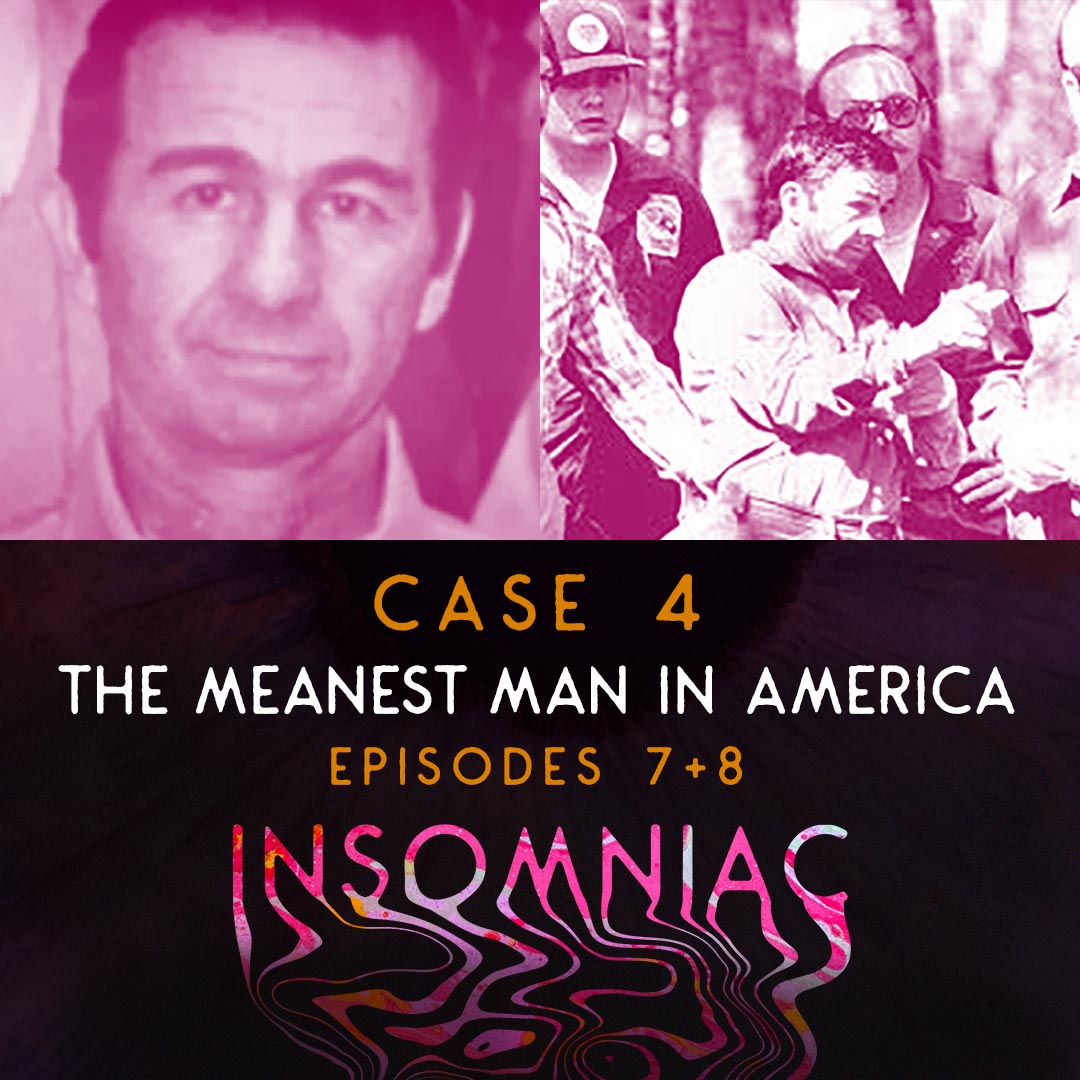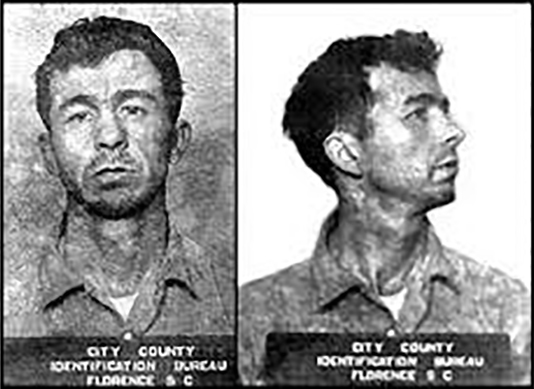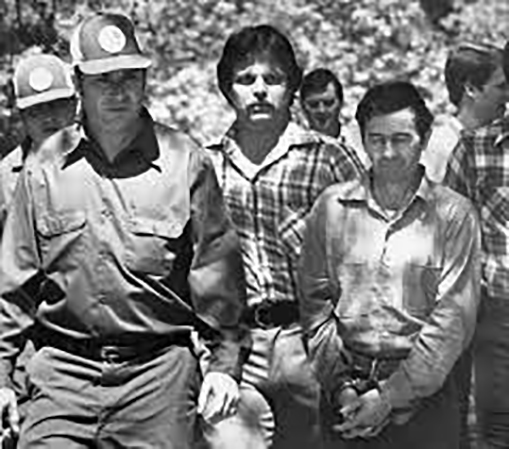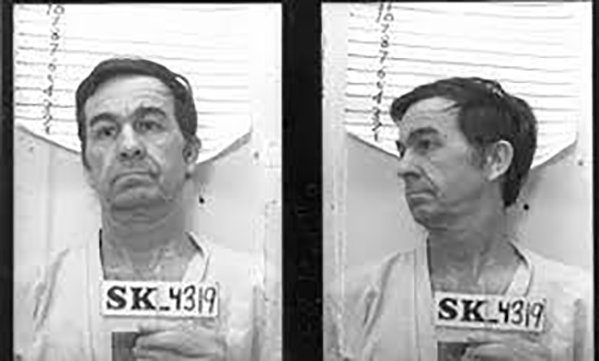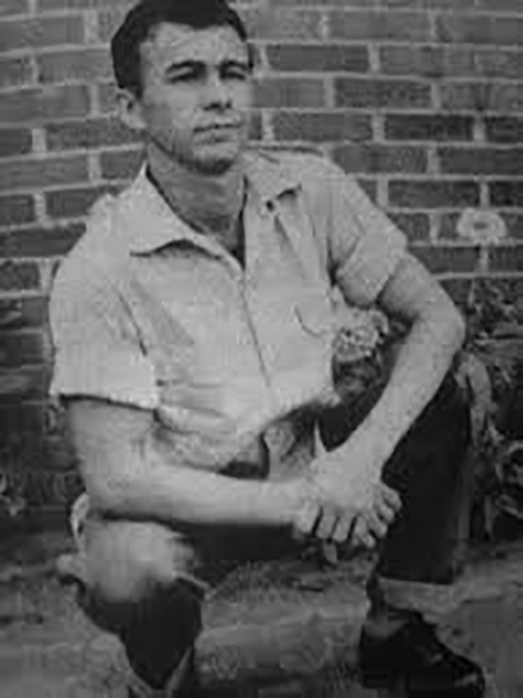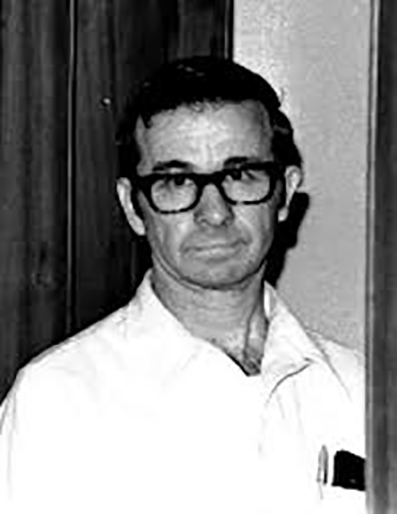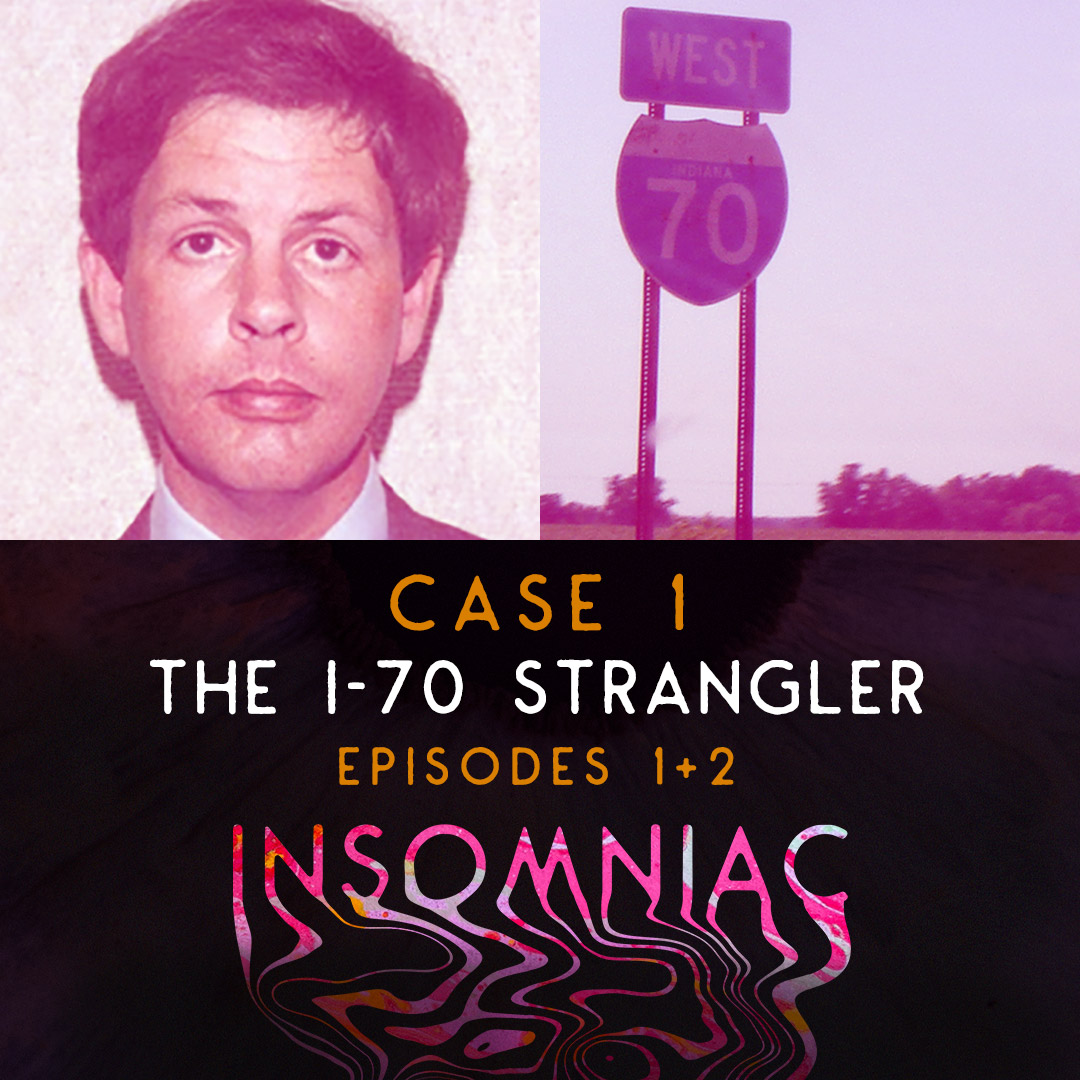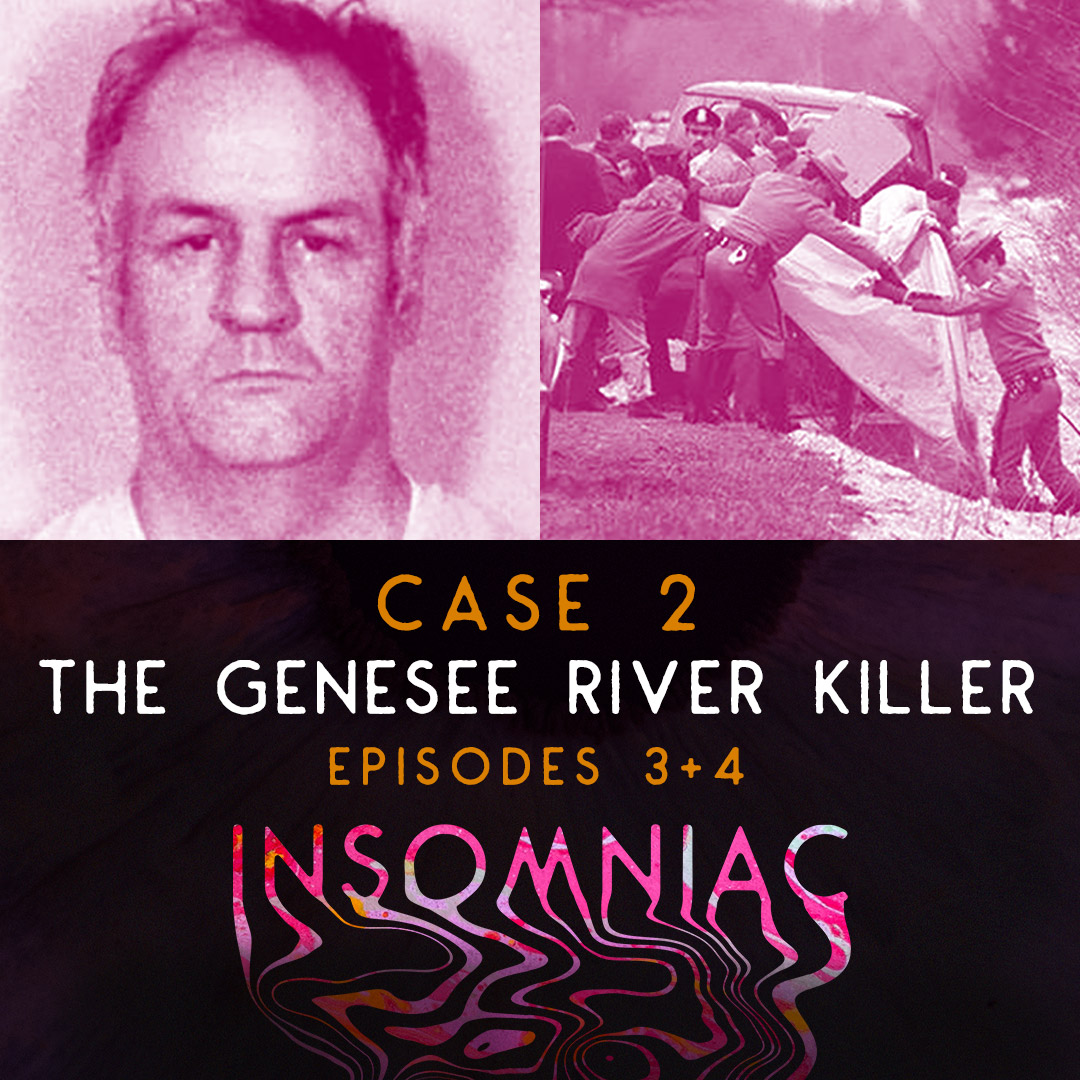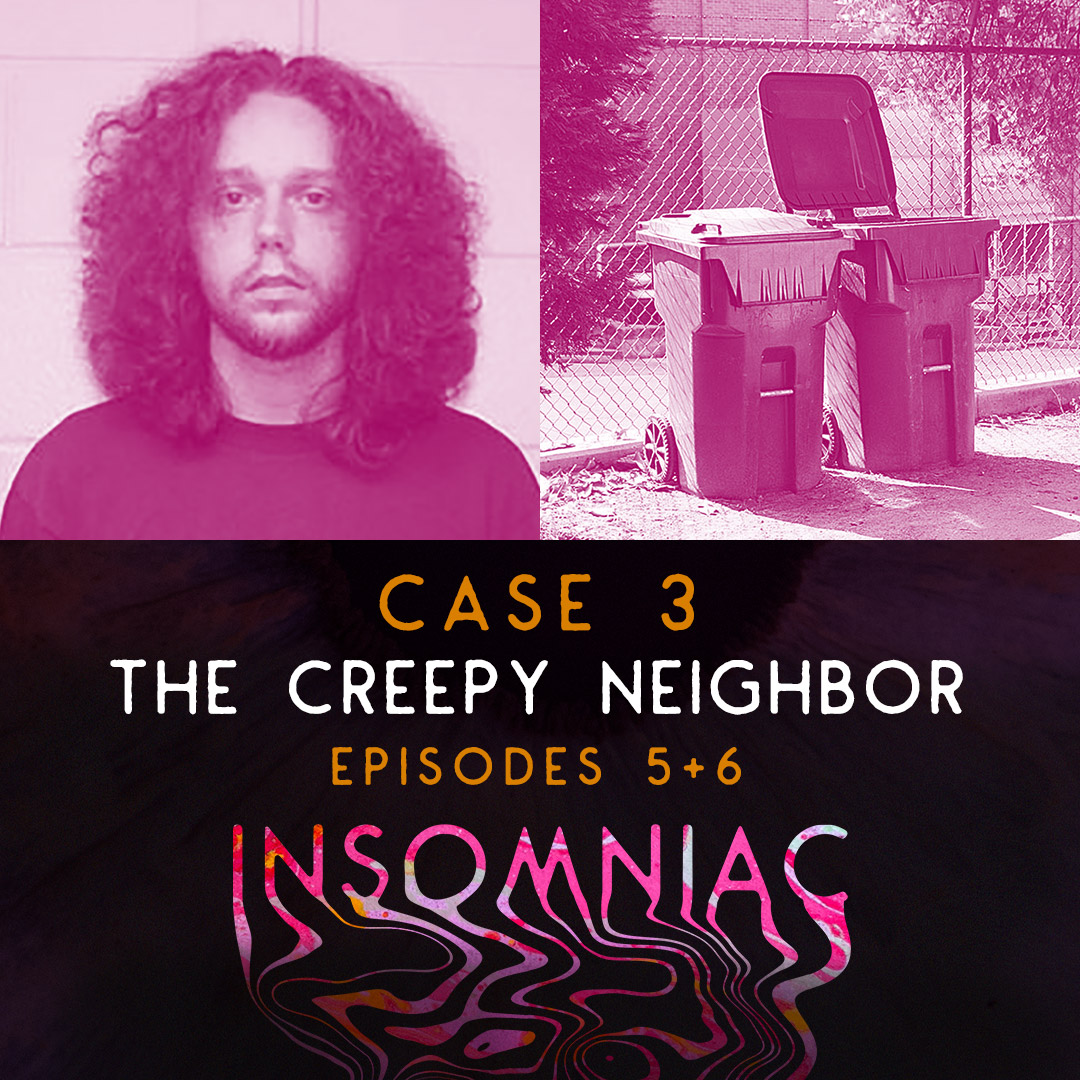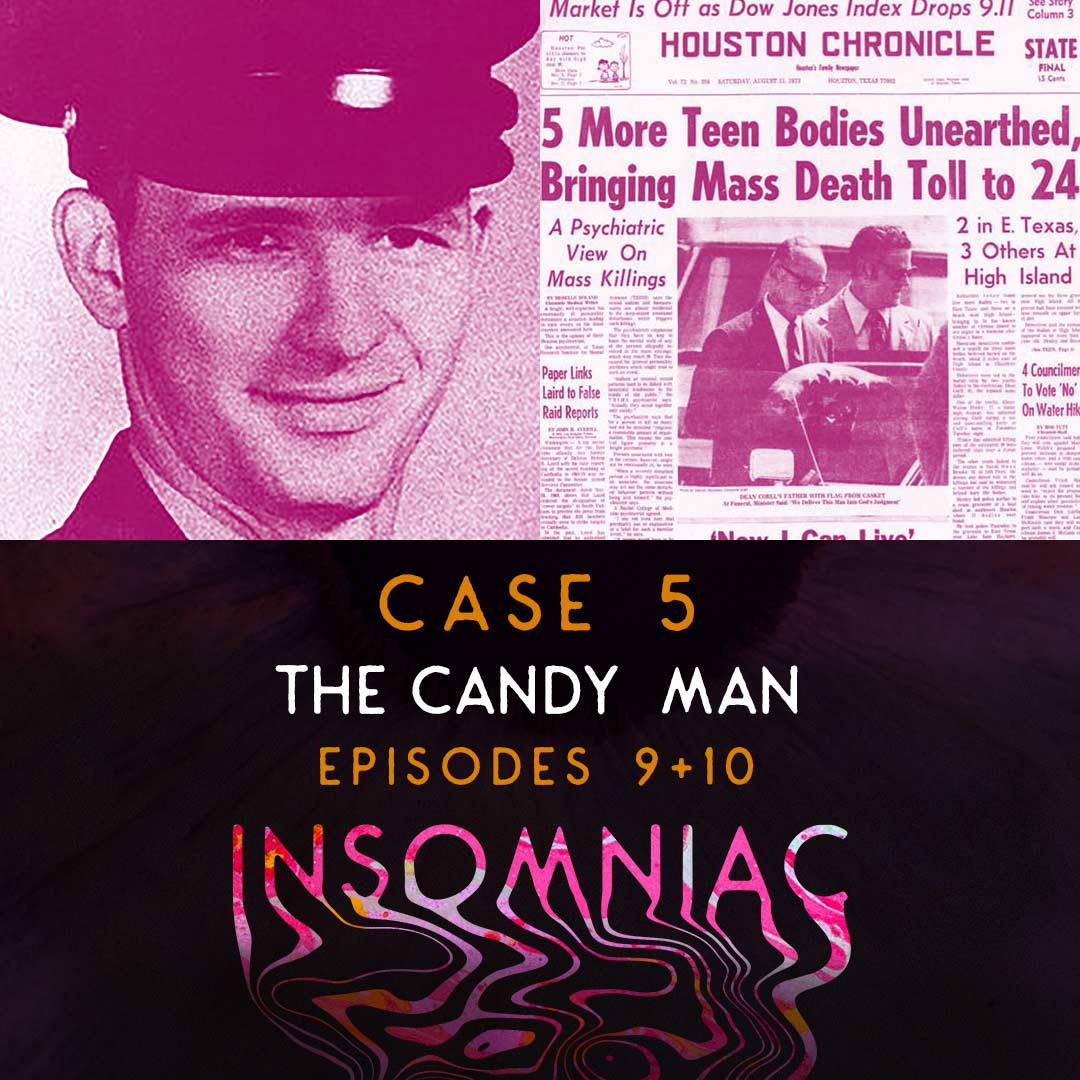case 4
Donald Henry “Pee Wee” Gaskins
The Meanest Man In America
Where Did It Stop?
Donald Henry “Pee Wee” Gaskins Jr. was also known as “The Meanest Man in America.” A nickname that he earned over a lifetime of criminal activity. Gaskin’s killing spree lasted from 1953 to 1982. And while he was convicted of just 9 murders, Gaskins bragged about the 80 to 110 additional notches on his belt — victims he tortured and murdered strictly for pleasure — but whose bodies have never been found. In 1982, while in a South Carolina prison, Gaskins used explosives to kill another death-row inmate. It was one of the most unlikely and bizarre murder plots ever carried out in an American prison.
Part 1
Part 2
To say that Pee Wee had a difficult childhood would be an understatement. He was neglected as a child and was even said to have drank a bottle of kerosene when he was just one year old. This caused him to have convulsions until the age of 3. Pee Wee would later tell others how he was neglected as a kid. “Being born on a farm, I know the difference between raising something and it just growing. You raise tobacco and vegetables, pigs and sheep. They got purpose. You tend them. But weeds grow on their own tended or not. I grew. I wasn’t raised. That’s for damn sure.”
Scott Benjamin, host
Gaskins, a 124-pound assassin whose height was about 5’2”, had a falsetto voice and chirpy personality. Before the law caught up with him, he drove around in a hearse and had his private graveyard in rural Florence County where he buried victims.
Aside “from his propensity for committing murder, Pee Wee was a typical good ol’ boy …. Unusually clever, he had a great sense of humor and a devil-may-care attitude,” wrote John Griffin, a University of South Carolina-Lancaster professor who wrote an authoritative biography of Gaskins.
Gaskins just loved to kill, said Columbia attorney and Sen. Dick Harpootlian, D-Richland, one of the prosecutors who put Gaskins in the electric chair in 1991.
Part 1
Transcripts
Part 1
Payne Lindsey: The views and opinions expressed in this podcast are solely those of the authors and participants, and do not necessarily represent those of iHeartMedia, Stuff Media, or its employees. Listener discretion is advised.
From iHeartRadio and Tenderfoot TV, Monster presents, “Insomniac.”
Scott Benjamin: 00:26 In the late evening of September 5th, 1991 just hours before his scheduled execution, Donald Henry Gaskins, age 58, better known as Pee Wee Gaskins, was found bleeding in his holding cell. Gaskins had coughed up a razor blade he had previously swallowed and used it to slit his own wrists. It was either as last ditch effort to stall the execution process or to altogether rob the South Carolina authorities of their planned execution of the convicted killer. Either way, it didn’t work.
Scott Benjamin: 01:05 They stitched him up, bandaged his still leaking risks and led him do the electric chair as scheduled. It was now the early morning hours of September 6th, 1991 just after midnight and he had just minutes to live. Pee Wee was aptly named, but despite his diminutive size, he was something of a larger than life character, only not in the way anyone would ever admire. In fact, Pee Wee seemed to be rotten from the time he was a young boy right up until the very minute he died.
Scott Benjamin: 01:46 In addition to his crimes on the outside and later his crimes on the inside, one of which he would pay for with his own life, Pee Wee had somehow managed to pull off what was likely the most audacious death row killing of another inmate that the US and maybe even the world at ever seen. Once you learn who peewee was and how he lived his corrupt life, you’ll think that he would have had something profound or even outrageous to say as he was strapped to the electric chair on that September evening. But his last words were simply, “I’ll let my lawyer speak for me. I’m ready to go.”
Scott Benjamin: 02:26 Shortly after those words were uttered, the man who earned the nickname The Meanest Man In America was dead at 1:05AM on September 6th, 1991. I’m Scott Benjamin and everything I’m about to tell you is real. This is Insomniac. He was eventually called the meanest man in America, but he was also known as The Hitchhikers Killer and The Redneck Charles Manson. Admittedly, he had a funny nickname for a grown man, Pee Wee, but let me assure you, there’s absolutely nothing funny about the life and the seemingly endless crimes of this undersized criminal.
Scott Benjamin: 03:19 When he was a fully grown man, Pee Wee stood just five feet, two inches tall and weighed about 130 pounds. He had always been small for his age and he clearly wasn’t ever going to intimidate anybody with his size, but Pee Wee didn’t need size to strike fear into the lives of those around him. He endured a lifetime of torment and pain, and he would return that pain and suffering to those unfortunate enough to cross his path. His criminal record spans decades any more than are in the reputation as the meanest man in America. In the end, Pee Wee would claim he was responsible for more than 100 murders, men, women and even children among his victims, yet he was convicted of just nine. We say just because those crimes only begin to tell his story. Was the South Carolina native as violent as he claimed to be or was he just trying to inflate his image to be known as the most prolific serial killer to date?
Scott Benjamin: 04:25 Many of these killings were never proven, of course, and maybe he was just bragging, but when he was alive, Pee Wee claimed to be one of the deadliest serial killers on record, and there was good reason to believe him. To begin, we have to travel to Florence County, South Carolina on March 13th, 1933 the day when a tiny four pound baby boy named Donald Henry Parrot Jr. was born. Of the long list of illegitimate children born to his mother, you, Eulea Parrot, Donald Henry Parrot Jr. was the last. Not only was he the baby, but he was also the smallest of all of her children. Right from the beginning Pee Wee earned his nickname among his siblings and friends for a small size. Growing up he was always small for his age. To say that Pee Wee had a difficult childhood would be an understatement. He was neglected as a child and was even said to have drank a bottle of kerosene when he was just one-year-old. This caused him to have convulsions until the age of three Pee Wee would later tell others of the way he was neglected as a kid.
Scott Benjamin: 05:47 “Being born on a farm, I know the difference between raising something and it just growing.” He raised tobacco and vegetables, pigs and sheep. “They’ve got purpose. You tend them, but weeds grow on their own. Tended or not, I grew. I wasn’t raised, that’s for damn sure.” He was always a poor student, didn’t get along with the other kids, and he quit school at the age of 11. He took a job as a mechanic at the local garage and he had always seemed to be mechanically inclined. He could fix almost anything, toys, cars, appliances, electronics, you name it. He could repair it.
Scott Benjamin: 06:34 When Gaskins was just 13-years-old, he and two other boys from town, Danny and Marsh, formed a group called The Troubled Trio. The trio began burglarizing homes, raping young boys and picking up prostitutes in nearby cities. As a part of the juvenile delinquent group, Pee-Wee’s first arrest came early, when he was just 13-years-old. Having answered to Pee Wee his whole life, he first learned his real name when it was read aloud during this court appearance for a crime spree Gaskins committed with The Troubled Trio. At 13, Pee Wee was still too young for jail. He was confined in the South Carolina Industrial School, a reform school for boys until he turned 18-years-old. As you can imagine, it was not a good experience.
Scott Benjamin: 07:29 While at the reform school, he was tormented and even gang raped by as many as 20 other young inmates. From that point forward, he spent all of his time either accepting protection from the boss boy in exchange for sex or plotting his own escape. Pee Wee had grown so accustomed to being a target that all of this was nothing new to him. Due to his small size Pee Wee was regularly the focus of attention from bullies and often found himself in a position of having to endure violence in school just as he was now experiencing in the reform school.
Scott Benjamin: 08:09 Pee Wee eventually did manage to escape the school and while he was out he got married to a 13-year-old girl and lived on the run for a while. This was the first of many marriages he would have, six in total over the years, but none of them knew about his other brides and he would only ever divorce one of the women. Going on the advice of his current mother-in-law, Pee-Wee soon returned voluntarily to complete his sentence at the reform school. He finished his sentence and was released in 1951 when he was 18-years-old. After his sentence was served, Gaskins took a job on a local tobacco plantation. It wasn’t long before he found a way to make additional money.
Scott Benjamin: 08:58 He found a partner to conduct insurance fraud with and they would work with tobacco farmers to burn their barns for a fee, collecting the insurance pay out. By 1953 he was known as a barn burner and people were onto him. Gaskins’ employer’s daughter and friend confronted of Gaskins about his reputation as the barn burner and he wasn’t happy. In a rage he hit her in the head with a hammer, split her skull. This led to a six year prison sentence at the South Carolina Central Correction Institution for assault with a deadly weapon and attempted murder.
Scott Benjamin: 09:37 Upon arrival, similar to his time in reform school, Gaskins was attacked by the other inmates. He was raped and owned in prison by the older, bigger inmates, but in order to become a more powerful player while he was behind bars, Pee Wee knew that he had to make a change. In order to survive he knew what he had to do. He had to kill somebody in prison to become what was known as a power man. Gaskins managed to manipulate himself into a relationship of trust with Hazel Brazell, the fiercest power man in the prison at the time. After gaining the man’s trust, Gaskins cut his throat.
Scott Benjamin: 10:24 It was the first time Pee Wee had ever killed and it gave him a sensation unlike anything he had ever felt before. Pee Wee was found guilty of manslaughter and he spent the next six months in solitary confinement, but he was now known as a power man among other prisoners. Things would be different for Pee Wee moving forward. For his crime, the killing of Brazell, Pee Wee would spend an extra three years in prison, but he got his wish. He was no longer a victim. He was now the top dog. He was the bully.
Scott Benjamin: 11:13 As part of my research for this episode, I took the time to read Pee Wee Gaskins memoirs, Final Truth: The Autobiography Of A Serial Killer by Donald Gaskins and Wilton Earle. It’s his life story in his own words and he doesn’t hold back, even revealed a few things he wouldn’t tell the authorities while he was alive out of fear for how he would have been treated in prison. Some of the things Pee Wee says in his book are far more graphic and harsh than just about anything I’ve ever read in my entire life, and as you can imagine, I’ve collected a lot of true crime books over the years. Pee Wee’s descriptions of not only his many murders and violent attacks, but also the rape and torture of many women and men and even one infant are so descriptive that they left an impression on me. It will take more than a little while to forget.
Scott Benjamin: 12:05 The only other true crime book I’ve ever read that even comes close to this level of brutality is a book that was written by another serial killer, Gerard John Schaefer while he was in prison. That book was called Killer Fiction. The reason these two books stand out among others is simple, they’re written by the killers themselves. when a man gets to a point where he can say anything he wants without the fear of prosecution or judgment by others, he can freely admit to anything and everything evil that he’d done throughout his entire life.
Scott Benjamin: 12:39 This can be read in one of two ways. It could be thought of as this final confession or it could be a way for the killer to brag or boast about his crimes one final time while people are still paying attention to what he has to say. Pee Wee saw his book as a way confess everything you’d ever done and what he left behind is a stomach churning, deeply disturbing piece of literature, if you can call it that. It will no doubt haunt you for a long time to come. Yes, there are detailed descriptions of murders and rapes in plenty of true crime books and many of them are quite vivid, but very few can compare to the brutal descriptions found in Pee Wee’s book.
Scott Benjamin: 13:29 You would think that Pee Wee would have almost enjoyed the remainder of his time in prison, after all, he was now looked upon with some respect after having killed Hazel Brazell. However, in 1955, by hiding in the back of a garbage truck, he was able to escape from prison and he quickly fled to Florida. He avoided arrest by working with a traveling minister as his driver and general assistant. Eventually, he was discovered and arrested soon after, but he was once again paroled in August of 1961.
Scott Benjamin: 14:07 As soon as Pee Wee got out of prison, now age 28, he immediately went back to his old way as a burglary, stealing and fencing stolen property. There he met her, another young woman, she was 17 and married for the fourth time. She found out he was on the run and she eventually turned him into the police who convicted Gaskins of the 12-year-old’s rape. He received six years at the Columbia Penitentiary and was eventually paroled in November, 1968. Pee Wee was now 35-years-old. Upon his release, Pee Wee moved to the town of Sumter, South Carolina and took a job with a roofing company.
Scott Benjamin: 14:57 He was a convicted murderer, but at this point he had only killed in prison. Throughout Gaskins’ life, he described feelings that forced him into criminal activity, which he referred to as “them aggravated and bothersome feelings.” In September of 1969, he found a way to get relief from those feelings. He became a killer once again. This was the first of what you would call his coastal kills, murders that he committed simply for his own pleasure. Gaskins picked up a female hitchhiker in North Carolina and he became angry when she laughed at his sexual propositions.
Scott Benjamin: 15:39 He beat her until she was unconscious. Gaskins then raped, sodomized and tortured her. He took her to a swamp, weighed her body down and sank her into the murky water. Later he would recall the enjoy the feeling of power he had over her. She was helpless. He said, “All I could think about is how I could do anything I wanted to her, anything.” This was just the first of many, many victims that Pee Wee would leave in his wake. He drove around the American South hiding the bodies as he went about his work. His so-called coastal kills were both male and female. All were killed strictly for his pleasure and as he claimed, one was taken approximately every six weeks.
Scott Benjamin: 16:35 Later Pee Wee would claim his coastal kills were even more frequent, one before the 10th of each calendar month. He had finally discovered how to satisfy as urges, and from that point on, it was the driving force in his life. He worked on mastering as skill of torture, often keeping his mutilated victims alive for days. As time went on his depraved mine group darker and he committed even more horrific crimes. He even ventured into cannibalism, eating the severed parts of his victims while forcing them to watch in horror. On occasion, forcing them to participate by eating their own flesh.
Scott Benjamin: 17:33 At night I’ve started to psych myself out about sleep, laying awake in the darkness, trying to force myself to rest when I know I’m supposed to. Sometimes I watch the clock as I count down the hours until I have to be up for work. If I get to sleep now I’ll get four hours of rest. If I get to sleep now I’ll have three hours of rest and you know how the rest goes. I always feel like I’m in a mental fog, just sort of making it through the day in a Zombie like fashion. If these sleepless or nearly sleepless nights last for more than three or four evenings, the feeling I get is the sorted delirium.
Scott Benjamin: 18:12 No hallucinations for me. Not yet, but it’s like my brain and the rest of my body don’t want to work at the same speed. I have days when I have trouble speaking more than even a few words at a time, struggling to get through meetings and conversations with coworkers, having to apologize the entire day for my mistakes. All of this is embarrassing. I can’t take operating like this for too much longer. Nighttime is supposed to be a time to replenish yourself, to sort out the day’s events and clear your mind of any troubles, to recharge your batteries and get ready for the next day. Instead, it only seems to be adding to the problem, or maybe it is the problem, I don’t know.
Scott Benjamin: 19:06 Throughout his life, Pee Wee Gaskins would operate his own chop shop for automobiles, a garage where stolen cars were brought to be either repainted and sold at auction out of state or completely stripped and sold for parts. It’s a lucrative business, completely illegal of course, but profitable., In the year 1973 Pee Wee had the opportunity to buy an old hearse. It happened when one of Pee Wee’s criminal associates drove up one day in the old stolen car looking to get rid of it as soon as possible. Pee Wee couldn’t resist and he bought the car for his own personal transportation.
Scott Benjamin: 19:45 While driving a hearse might sound like an unusual choice for anyone, a lot of people simply have an interest in that type of vehicle. For one, they’re all custom built. They aren’t mass produced, so each example is a one of a kind in some way or another. They’re also typically beautiful in design, inside and out, because they’re created from top end luxury cars like Cadillac, Lincoln, Mercedes-Benz, or even Rolls Royce. Another point is that they’re unusual, interesting and well, simply different, so they have some appeal to certain car enthusiasts too, not just those in the funeral industry or the occasional serial killer. Pee Wee on the other hand, viewed only a hearse as an opportunity. He could use it for its intended purpose and do it right under the noses of the authorities. Pee Wee was flippant with his friends and even the local police about what he was up to.
Scott Benjamin: 20:41 For instance, when asked about the hearse while sitting at his favorite bar he would say needed the vehicle to haul all the people he killed to his own private cemetery. Everyone would laugh it off as if it was a good joke and then go back to drinking or whatever they were up to. But the reality was that Pee Wee was using the vehicle for exactly that purpose, hauling the dead bodies of his victims to his own private cemetery, some out of the way property he owned in Prospect, South Carolina. Pee Wee felt that if the authorities would laugh and joke with him about the hearse and its use, they weren’t concerned about him as a suspect and he could hide in plain sight. Even had a sign in the back window that said, “We haul anything living or dead.”
Scott Benjamin: 21:39 Pee Wee’s level of violence was escalating and he even created his own new category of murders, one that he kept entirely separate from his random coastal kills. There was a twist to the story too. A single murder that will cost Pee Wee his own life in the end, the same murder that was thought impossible by everyone and the reason he was known as The Meanest Man In America. Next time on Insomniac.
Speaker 3: 22:13 Insomniac is a production of iHeart Radio and Tenderfoot TV, written and hosted by Scott Benjamin and produced by Miranda Hawkins, Alex Williams, Matt Frederick and Josh Thane. Music composed by Makeup and Vanity Set and cover art by Trevor Eiler. Follow on Twitter and Facebook @insomniacpod, on Instagram @insomniacpodcast and at our website insomniacpodcast.com. For more podcasts from iheartradio, visit the iheartradio app, Apple Podcasts, or wherever you listen to your favorite shows.
Part 2
Payne Lindsey: The views and opinions expressed in this podcast are solely those of the authors and participants and do not necessarily represent those of iHeart media, Stuff Media or its employees. Listener discretion is advised. From Iheartradio and Tenderfoot TV, Monster presents INSOMNIAC.
I’m Scott Benjamin, and everything I’m about to tell you is real. This is Insomniac.
It was now the early 1970s. Donald Henry “Pee Wee” Gaskins Jr was still killing for recreation to satisfy his bothersome urges, but now he had moved on to something new. In addition to his recreational kills, Pee Wee was now committing a different type of murder altogether. He was killing people he knew or even those that were related to him for personal reasons. He called these his serious murders, and he handled them in an entirely different way.
Pee Wee was known to keep his coastal kills alive for an extended period of time. In fact, keeping them alive as long as possible, cruelly torturing them in a variety of ways before killing them. His methods of murder included stabbing, suffocation, mutilation, and later he claimed to have even cannibalized some of his victims. You’ll find graphic descriptions of these acts in his autobiography, Final Truth.
By 1975, at age 42, Pee Wee claimed to have killed over 80 young girls and boys he found along the Carolina highways, and that number was still growing.
His first serious murder victims were taken in November of 1970. His own niece, Janice Kirby, age 15, and her friend, Patricia Ann Allsbrook, age 17, both of Sumter, South Carolina. He was angry with them for attempting to run away from home, and when he found them, both girls were high on some sort of drug or possibly drunk.
He offered the two girls a ride home from the bar where he found them, but instead drove them into an abandoned tenant house. There, he raped, beat and drowned the girls in separate locations.
Typically, there was no torture or mutilation involved in his serious murders. Instead, he simply executed them quickly by shooting them, and then buried them somewhere in the coastal area of South Carolina. In the years to follow, his other murder victims would be killed for a variety of reasons. If anyone mocked Pee Wee, he’d kill them. If anyone attempted to blackmail him, he’d kill them. If someone owed him money, or if they stole from him, that was another reason to kill. It was also known among others in town, particularly his criminal associates, that Pee Wee could be paid to kill someone.
In the year 1982, Pee Wee Gaskins pulled off what many thought to be an impossible murder. Another inmate on death row named Pop told Pee Wee that there was a man on the outside that had good money and good connections, and he wanted a row man shanked. His name was Tony Cimo, and he was looking for revenge. The row man was Rudolph Tyner, and he had killed both of Cimo’s parents during the holdup of a little store they owned.
Tyner was caught on the scene and sentenced to death by electric chair in the state of South Carolina. Cimo was tired of waiting for Tyner’s many appeals to be heard, or the possibility of a sentence being overturned or commuted to life, so he decided to hire a man on the inside, another death row inmate, to kill Tyner as soon as possible. And that’s how Tony Cimo was introduced to Pee Wee Gaskins.
Because security was so tight and the condemned inmates were kept in solitary confinement, a death row murder by another inmate was virtually impossible, so this one would take a lot of planning and time to lay the groundwork. Pee Wee studied his prey by getting his hands on Tyner’s prison file and finding out from the kitchen trustees what kind of foods and drinks Tyner ordered. He then started to gain Tyner’s trust by having drugs delivered to his cell. Marijuana, heroin, pills of all kinds, whatever he could get his hands on. That progressed of visits with Tyner.
Since Pee Wee could repair almost anything, he was initially asked to repair a leaking pipe in Tyner’s cell and the two began a conversation. After that, Tyner would intentionally break the pipe over and over just so he and Pee Wee could talk while the repairs were made. The two even discovered they could talk between their cells via a shared heating duct.
Once he had gained Tyner’s trust, Pee Wee began to put his plan into action. He made several attempts to kill Tyner by slipping poison into his food and drinks whenever he had the opportunity. Poison provided by Tony Cimo. The poison, which Cimo described as strong enough to kill a horse, was not enough to take down Tyner. After five failed attempts with each one of them merely making Tyner ill but not even sick enough to be sent to the infirmary, Pee Wee had enough of the poison, and told Tony Cimo that he needed something stronger. He needed explosives.
Tony Cimo was able to smuggle in or to have smuggled in for him everything Pee Wee needed. A piece of C4 plastic explosive about the size of a baseball, a length of electrical wire, and screw connectors and plugs he needed to set it off. All of this was brought in piece by piece, and delivered to Pee Wee in his cell. He claimed he had help from prison officials to make this happen, but that was never proven.
On his next visit to Tyner’s cell, Pee Wee told him that he had found a way that they could communicate easier between their cells. You would rig up an electric homemade telephone using speakers made of plastic cups from the mess hall, similar to the ones made by kids using tin cans and string. But instead of making a speaker, Pee Wee stuffed the bottom of the cup with the explosive, covered it with speaker cloth, and had it delivered to Tyner. Pee Wee then lowered the power cord through the shared heating duct into Tyner’s cell, and instructed him to connect the two wires to the screws in the bottom of the cup.
The two had earlier planned a specific time to test the communication device where Tyner would say loud and clear into the speaker, “This is Tyner. Over to you,” and then put the device up to his ear to hear the response. At the agreed upon time, Pee Wee listened through the duct work for Tyner to say the phrase. Pee Wee waited just long enough for Tyner to move the cup to his ear, and he plugged in his end to the power cord. The explosion shook the entire cell block. Pee Wee then pulled the end of the power cord back into his own cell, coiled it up under his mattress to dispose of later, and then joined the rest of the inmates on the tier asking what had just happened.
Tyner was dead. There was no doubt about that. But Pee Wee didn’t get to see the gory result of his efforts, at least not on that day. At his resulting trial, Pee Wee was able to see the crime scene photos of Tyner’s body in his cell. As Pee Wee said in his book, “There was bits and pieces of in stuck all over the walls and ceiling and floor.”
Pee Wee had accomplished the impossible, the murder of another death row inmate, and he’d gone about it in a way that no one ever imagined he could. The jury handed down a guilty verdict for Pee Wee, and for Tony Cimo, too. Pee Wee was given the death penalty, and Cimo received a sentence for 25 years in prison, but was eligible for parole after just 30 months.
Pee Wee didn’t feel justice was properly served in his case. Instead of being sentenced to die in the electric chair, Pee Wee said that he felt he should have been paid for killing Tyner. As he put it, “For doing the state’s job since they was going to murder him they selves if I hadn’t got to him first.”
Following the November 1970 murder of his niece and her friend, Gaskins’s next serious murder was a 20 year old named Martha Dicks. Pee Wee had discovered she was the one who had sold his niece the drugs.
Dick’s was attracted to Pee Wee and often hung around him at his part time job at a car repair shop, but apparently Pee Wee didn’t feel the same attraction. He killed her with a strong dose of acid he had stolen from a photographer. He poured it into her Coca-Cola, and she unknowingly ingested the fatal dose. The acid worked fast, and she died a relatively quick but painful death right in front of him.
In 1973, another young woman who considered Gaskins a friend was 23 year old Doreen Dempsey. Doreen was a mother of a two year old baby girl named Robin Michelle, and she was pregnant with a second child at the time. She felt comfortable enough around Pee Wee to accept a ride to the bus station. After all, Pee Wee was an old friend. Instead, Gaskins drove her to a secluded wooded area, raped and killed her in the back seat of his hearse, and then raped and sodomized two year old Robin Michelle before killing her, too. Pee Wee provided a graphic description of this pair of rapes and murders in his book, and the details are just as horrific as you might imagine. Again, this book isn’t for everyone.
At the time, no one suspected Pee Wee Gaskins was capable of such the district killings, but word was getting around about Pee Wee, and there were a few people in town who knew that he would do it if the price was right.
In 1975, a year that peewee would later call his “killingest” year, Gaskins got a little careless and murdered three people whose van had broken down on the side of the highway. Gaskins suddenly found himself in need of a favor. He needed help getting rid of the trio’s van, and he enlisted the help of an ex-con, Walter Neeley. Neeley and Gaskins went about their own criminal business, but would occasionally help out each other if they were in need of some sort of assistance, disposing of stolen cars, stolen goods, and occasionally bodies.
Also in 1975, a woman named Suzanne Kipper Owens hired Pee Wee to kill her ex boyfriend, a man by the name of Silas Barnwell Yates. Yates was a wealthy farmer in Florence County, South Carolina. Gaskins and a pair of accomplices were successful in kidnapping and murdering Yates and he collected the $1500 Susan Owens had promised him.
But things went wrong as soon after, and Pee Wee realized that he had to kill two additional people to cover up the Yates murder. His accomplices were 29 year old Diane Neeley and 35 year old Avery Howard. Diane Neeley was the wife of Walter Neeley, and she and Howard, an ex-con, were having an affair. The pair attempted to blackmail Gaskins for $5000 in hush money after assisting in the abduction and murder of Silas Yates. The two were quickly killed by Gaskins after they agreed to meet Pee Wee at the payoff location.
In the meantime, Gaskins was busy killing and torturing more coastal kills, as well as other people he knew, including a 13 year old named [Kim Gilkins 00:00:13:23], who sexually rejected him. All leads in the investigation of the disappearance of Kim Gilkins pointed to Gaskins, but there was no body yet, so there was no arrest. The authorities eventually did find evidence implicating Pee Wee, so he was indicted for contributing to the delinquency of a minor, and kept in jail until his trial.
Walter Neeley was also being held, but during that time, he began to speak with a local preacher, and they began to pray together. They prayed for forgiveness, and when Walter Neeley was ready to confess his sins to God, he was also ready to speak to the authorities. Neeley claimed that he had witnessed Gaskins killing two young men, Dennis Bellamy, age 28, and Johnny Knight, age 15. He also stated the Gaskins told him that he had killed several additional people, people that had been listed missing over the previous five years, and Neeley could even tell them where they were buried.
Soon after, in December of 1975, Walter Neeley led the police to the property Pee Wee owned in Prospect, South Carolina, and that is where the police would uncover the bodies of eight of his victims.
By the time of Pee Wee’s scheduled execution, he had been sitting on South Carolina’s death row for nearly a decade. In that time, he witnessed a lot of men slowly make their way to the electric chair, and as he waited his own turn, he learned a lot about the process. In fact, he learned everything about the process. The introduction section of Final Truth, Pee Wee’s book, shows he knew exactly what to expect on the day he was scheduled to die.
According to Pee Wee, this is how his final day would go. First, the warden would move him to a new building called the Capital Punishment Facility, also known as the Death House, and he would be locked in a cell right next to the death chamber, the room that contained the electric chair. While there, he would have 24 hour guard supervision to make sure he didn’t attempt to kill himself or take any drugs to help ease the pain of the execution in any way.
On the day prior to his execution, he would place an order for his final meal, which Pee Wee thought might be pizza. A strange thought since he didn’t even like pizza, but he was pretty sure he wouldn’t be able to eat it anyway. He would be allowed to take a final shower, and that’s when the guards would shave his head as well as the calf on his right leg. Then he would be given a clean, new, green prison uniform for the occasion.
Soon after, the prison chaplain would stop by his cell to speak with him, and to see if he had any final confessions to make. Then there was time to write maybe a couple of letters, or talk to his daughter on the phone one last time, but the rest of the time would be spent just waiting. Waiting for the time when they would lead him into the death chamber.
Around midnight on the night he was to die, in his cell, the paramedics would instruct him to empty his bladder and his bowels, and then they would begin to prepare him for the chair. A rubber band would be tightly wrapped around his penis, and cotton balls would be forced up his rectum so that he didn’t urinate and defecate all over himself and the chair when the electricity began flowing through his body. After he was dressed once again, prison guards would lead him into the chamber where they would sit him down in the sturdy, old oak chair, and secure a leather strap around his waist, as well as over his lap, and around his wrists and ankles so he wouldn’t arch up from the seat as a result of the lethal current.
A wet electrode would be taped to his right calf in the place where they had shaved earlier. Two guards would then tilt his head back and strap it in place while a third guard would fit the metal head piece, making adjustments to the wet sponge and the electrode at the top to ensure its position just right to send the first charge of electricity directly to the center of his brain. A black hood would then be positioned over his head so the witnesses couldn’t see exactly what happens to his face.
When the guard in charge was sure that everything was just right, he would signal the warden, who would then turn the key on the power panel. Three buttons on the panel would light up, but only one of the buttons is wired to actually deliver the death charge. Three men will simultaneously push one button each, and that way none of them knows who actually pushed the button that killed the inmate in the chair.
The power sent to the chair is controlled automatically, so it delivers an exact charge for an exact amount of time. The first is a five second charge that delivers 2000 volts at five amps. That’s followed by a second surge of 1000 volts for eight seconds.
Here’s how Pee Wee describes the moment he would receive the shock. “In the first three seconds after the buttons are pushed, my brain will be fried. My eyeballs will explode. The blood of my arteries and veins will boil. Then my lungs and guts will be cooked. And my leg will be charred where the current comes out, like my skull will be charred where it went. The theory is I won’t feel anything but that first zap. I damn sure hope the theory is right.”
After a doctor rules Pee Wee dead, the prison official will issue a statement to the press and public to say the sentence was carried out. The guards will then wait until all witnesses have exited the execution chamber before removing the black hood and prying the metal headpiece off of his charred scalp.
The next step for Pee Wee’s body will be the prison morgue, where he will be subjected to an autopsy to determine the cause of death. As Pee Wee said, “like it might could be something besides electrocution.”
It was a Sunday night, and it was my first time taking this particular prescription, an extended release sleeping pill. Turns out it didn’t mix well with my other medication. I lost Monday. I don’t remember waking up. I don’t remember getting dressed. I certainly don’t remember driving. What I do remember is arriving home Monday night still in a daze, and falling asleep almost immediately on the couch. I lost most of Tuesday, too. It wasn’t until after my two hour commute home that I noticed that the right front of my car was damaged. I don’t know when or where, but I’d hit something. Hard.
Panic set in immediately. I didn’t know if I’d hit another car. That was bad enough, but then the thought came to my head that I might not have hit something but rather someone, and that really made me worry. I didn’t know what I was gonna do, or how, or even where to begin searching for whatever or whoever I had hit. Unlike my nightmares, it wasn’t something I’d imagined. The damage I was looking at was real.
By the time I was able to clear my head, it was Wednesday morning. I looked at the missing trim pieces and the scratched bumper, and realized they were made by something very abrasive, bricks or concrete, and probably not another vehicle, but I didn’t know for sure. I drove through the parking structure that morning slower than I ever had before, searching for a car or truck that had matching damage. A vehicle with a new dent, telltale blue paint scuffs that matched my own. I was ready to write a note of apology to the car’s owner and accept blame, and that’s when I saw it.
As I drove up to my usual level, I saw an all new mark on the concrete wall ahead, a heavy black scuff mark with dark blue paint streaks on either side. I stopped my car just inches from the wall. The height of the scrape, the color of the paint transfer, it all matched perfectly. This was it, and I felt instant relief knowing that I hadn’t heard anyone else in my confusion. I had simply brushed the wall two days earlier while making a sharp left turn, and I never even realized it.
I was lucky this time, real lucky. The damage to my car is still there, of course, and it’s a daily reminder to me that medications aren’t the best way out of this mess that I’m in, so what’s better? Being exhausted all the time and just dealing with it? Or taking pills to help me sleep and losing control of my actions while forgetting several days in a row? I stopped taking that medication. It’s not worth the risk.
Timing is everything, and it seemed like Pee Wee was going to dodge a bullet. On April 27th, 1976, Pee Wee Gaskins was charged with eight counts of murder, and he was also a suspect and as many as 39 at this point.
Just shy of a month later on May 24th, 1976, a jury found both Pee Wee Gaskins and Walter Neeley guilty in the murder of a man named Dennis Bellamy, and both were sentenced to death. However, the sentence wouldn’t stick because in November the same year, the US supreme court ruled South Carolina’s death penalty as unconstitutional. Both sentences were commuted to life in prison.
Still technically sitting on death row, but no longer awaiting his date in the electric chair, Pee Wee could have lived out his remaining years in prison. However, in the following year, 1977, the death penalty ruling by the US Supreme Court was reversed, so it was legal once again in the state of South Carolina. At the time, this meant little to the already spared Gaskins, that is until he was found guilty of murdering fellow death row prisoner Rudolph Tyner in 1982. While in his cell and once again awaiting his scheduled execution date, Pee Wee told his life story to a journalist named Wilton Earl, who in turn wrote the condemned man’s memoirs, who agreed upon the plan of publishing Pee Wee’s book in his own words after his execution.
At that point in his life, Pee Wee had nothing to lose and nothing to hide, so it’s an extremely graphic, unfiltered look back at his entire life, including the neglect, abuse, and countless rapes he endured, as well as the rapes, mutilation, and torture murders he inflicted on others.
Pee Wee’s book was published a year after his execution on May 1st, 1992. An audio cassette was included with the book when it was initially released, and it contained excerpts from some of the interviews the author recorded with Pee Wee in prison. Copies of the original are very rare, but you can still find copies of the recordings online. To hear Pee Wee’s nightmare stories totally in his own voice is unsettling to say the least.
Speaker 1: 26:16 I was an evil man. A man on the parole board told me, he said, “I don’t believe you’ll be out six months and you’ll kill somebody, but we’re going to give you parole.”
Scott Benjamin: 26:30 Brace yourself, because what’s next I don’t even like to talk about. It’s one of the most horrific stories I’ve ever encountered.
Houston, Texas, in the early 1970s. An especially shocking story of power, manipulation and brutality. Next time on Insomniac.
Speaker 3: 26:59 Insomniac is a production of iHeartRadio and Tenderfoot TV, written and hosted by Scott Benjamin and produced by Miranda Hawkins, Alex Williams, Matt Frederick, and Josh Thane. Music composed by Makeup and Vanity Set, and cover art by Trevor Isler. Follow on Twitter and Facebook at Insomniac Pod, on Instagram @insomniacpodcast, and on our website, insomniacpodcast.com.
For more podcasts from iHeartRadio, visit the iHeartRadio app, Apple Podcasts, or wherever you listen to your favorite shows.
More Episodes, More Cases
Case 5 | Part 1
The Candy Man
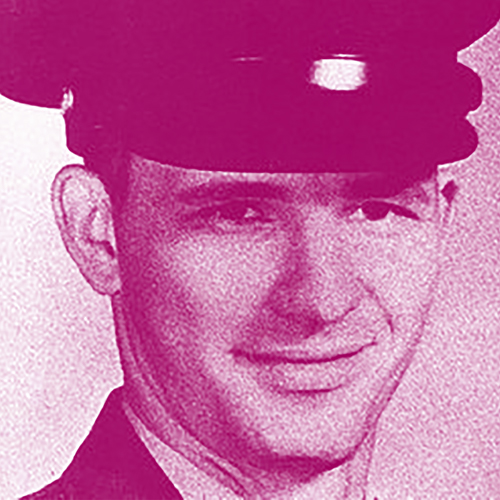
Case 5 | Part 2
The Candy Man
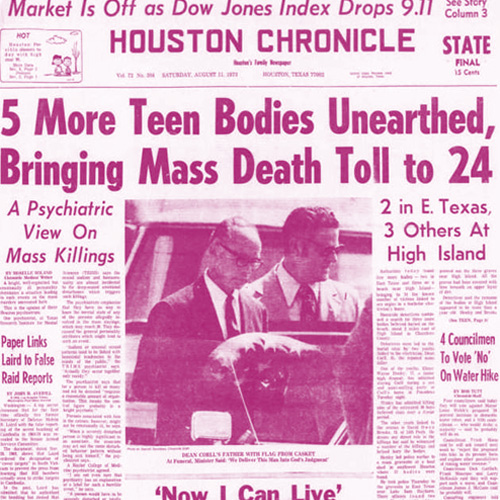
Case 1 | Part 1
The 1-70 Strangler

Case 1 | Part 2
The 1-70 Strangler


